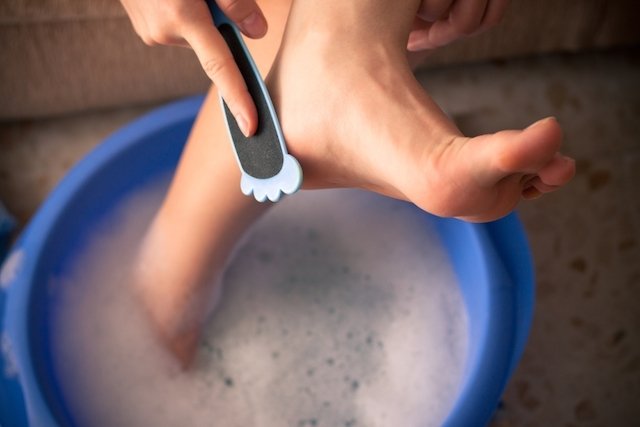Cracked heels can occur when the skin is very dry and the load of your bodyweight on your feet starts to break the skin. Pressure on the feet that can contribute to cracking includes running and going up stairs.
Te best pay to prevent cracked heels is to keep your feet hydrated and to apply cream at least once per day.
If your feet are already dry and cracked, you should engage in a daily foot care routine to keep them smooth.

What causes cracked heels?
The main cause of cracked heels is lack of skin hydration that lead s to less flexible and easily breaking skin. However, other factors can also contribute to cracked heels, such as:
- Walking barefoot excessively
- Frequently using sandals and flipflops
- Being overweight
- Taking very hot showers or baths
Decreased water intake throughout the day can also lead to dryer skin and a higher risk for cracked heels.
People with these risk factors should apply hydrating cream on the feet every day, either after showering or before going to bed. This will ensure the feet are well moisturized, which will prevent skin breaking during the day.
Foot care routine cracked heels
The following routine should be done at least twice a week when you notice your heels are very dry.
1. Hydrating foot soak
The first step consists of soaking the feet to soften the skin and open the skin pores. This allows for the cream to be well-absorbed into deeper layers of the skin.
To soak your feet, you should:
- Fill a bowl with warm water. The water should be about 8 to 10 cm in height, or it should be enough to allow you to fully soak your foot.
- Add 1 to 2 tablespoons of moisturizing cream to the water. This amount can vary depending on the amount of water used.
- Stir the cream into the water to dissolve it completely.
- Soak your feet for 5 to 10 minutes to ensure the skin becomes soft and absorbs the cream.
Ideally, your foot soak should not be done with got water nor without cream. The hot water will just open the pores and can leave the skin dryer.
2. Dry your feet thoroughly
After terminating the foot soak, it is very important to dry your feet thoroughly to prevent the growth of fungus, particularly between the toes. However, be sure not to rub the towel too vigorously to avoid irritating the skin and worsening the dryness.
Ideally, you should pat the skin dry to remove excess water, then allow your feet to air dry completely for 2 full minutes.
3. Use a foot file
This step is optional and should generally be done if the feet and heels are not cracked, but the skin is thick and dry. After drying the feet completely, use a foot file or pumice stone and gently file the feels to remove dead skin.
This technique can also be done on other dry areas of the foot, like on the side of the big toe. Once you are done, you can rinse your foot in warm water, or remove the excess skin with a towel.
4. Apply a hydrating cream
Once the foot is completely dry, apply a hydrating cream, which will close the pores. The thicker the cream, the more hydrating it is, and therefore you can select a cream as desired.
After applying the cream, put on socks to allow the cream to be totally absorbed. Socks can also prevent falls, as your feet may be slippery from the cream. A great option is to perform this routine before bed, so that you can relieve pressure from your feet for a few hours.
